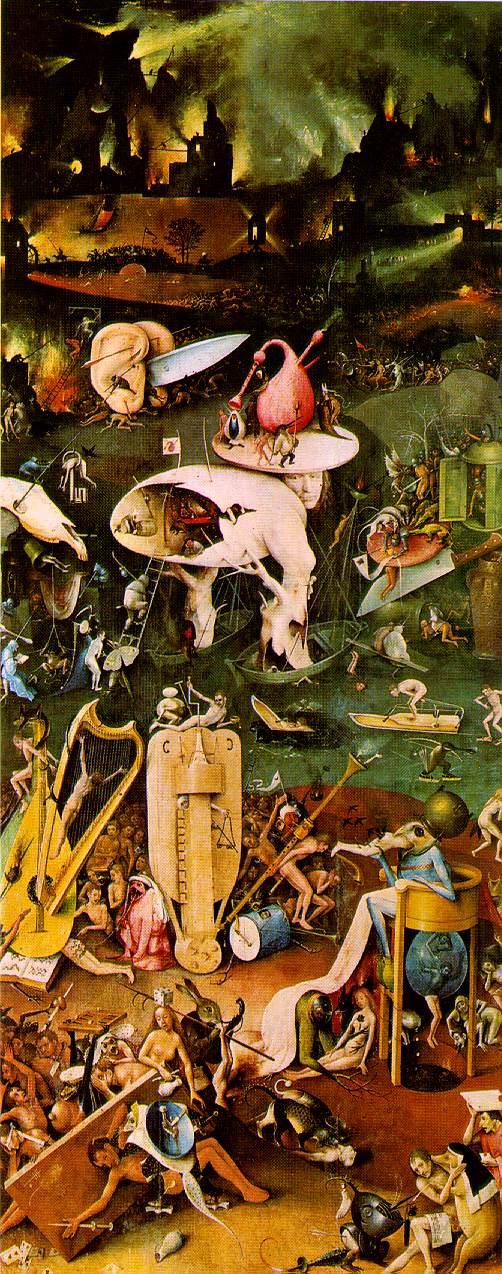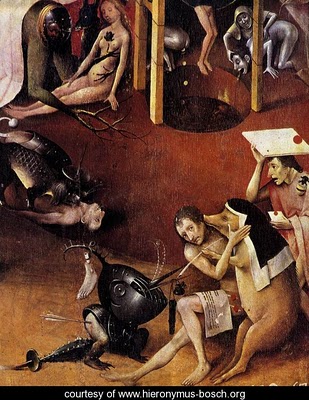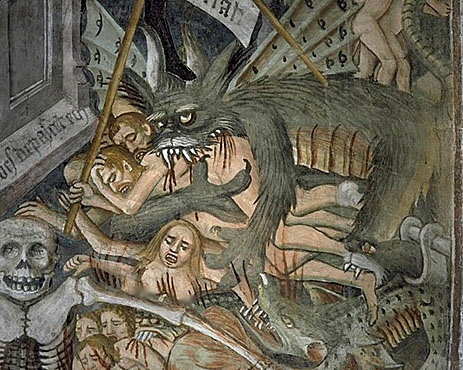Whenever Hieronymus Bosch deals with hell and the devils, he repeats this master idea with many variations: the idea that they are illogical, disorderly, incomprehensible, and mad. When we hear that Saint Anthony was tempted in the desert, we expect that Bosch will depict the devils as the saint himself saw them, in the forms of beautiful women, disputatious spirits, helpful monks bringing meals, or dangerous armed men and wild beasts. Not so.

Temptation of Saint Anthony. Middle Panel. "Yet many critics believe that Bosch's greatest work is the Saint Anthony Triptych, which hangs in one of the less-visited museums of the world, the Museu Nacional de Arte Antiga in Lisbon." Read More: http://www.stanleymeisler.com/smithsonian/smithsonian-1988-03-bosch.html
Most of the figures surrounding Anthony and distracting him from prayer, even from a vision of the Savior himself; are grotesque confusions of human, animal, and vegetable life mixed up with man-made objects. There is the hunchback dwarf on skates; he has a bird like head capped by a funnel with a dead twig stuck in it. There is a fish, whose body is a fishing boat and who wears a cuirass and a dagger. There is a giant rat carrying a fish-tailed treeman holding a baby. There is a dog-faced unicorn with wings, no body, and a pair of hind legs. And the upper air is inhabited by flying fish, birdlike ships, and other defiances of the laws of reason and nature.
The forces of hell in this picture do not concentrate on carnal lust. They are not endeavoring chiefly to arouse their victim’s passions by offering him savory food and rich wines and lovely girls. They are attempting to convince him that the world is quite meaningless, that there is no order in nature, that there is no reason why anything should be precisely what it is, that anything can come out of anything, that creation is being uncreated by the forces of unreason, and therefore that god is powerless or nonexistant.

"It is almost ridiculous how easily this can be related to humanism. For those of you who may have forgotten, humanism is essentially a way to approach the philosophy of human values. As shown Saint Anthony is surrounded by spirits and demons where his mind is being pulled in every direction. He is praying to help himself keep his values and for everyone else to regain their values. It’s important to realize the Renaissance came right after the Middle Ages, and humanism was defined and more popular during the Renaissance...." Read More: http://iampetjack.wordpress.com/2011/02/16/10/
If you study the monstrosities in Bosch’s paintings, yu come to see that he intends them not to be static but constantly changing. Bosch suggests that most of the sufferings of Anthony under temptation were caused by the fact that things as he looked at them, lost their shape and kept turning into something else and then into something else again. It is often ridiculous, this world of chaos, and sometimes quite comical. There is a humorous charm in the distracted little bodiless head sailing along in a dinghy and being pecked at by a featherless flamingo:
Picasso once said that every good work of art is a kind of joke. Diego Rivera, the revolutionary Mexican muralist, agreed.Every piece of worthwhile art, properly understood, is not only like a joke, it is shocking. It must connect its elements in a new way; the world comes to be seen in a new way. A punch line of a joke may get a laugh, or perhaps only a smile. A first view of a great work of art may make one smile, more likely not. But it will be shocking, often without the viewer knowing quite why. “So art may not be a joke,” Rivera said, “but it is always like one.” Read More: http://www.analysis.com/vs/vs85.html a

Garden of Earthly Delights. Right panel. Hell. "Bosch's most famous and unconventional picture is The Garden of Earthly Delights (c.1500; Prado, Madrid) which, like most of his other ambitious works, is a large, 3-part altarpiece, called a triptych. This painting was probably made for the private enjoyment of a noble family. It is named for the luscious garden in the central panel, which is filled with cavorting nudes and giant birds and fruit. The triptych depicts the history of the world and the progression of sin. Beginning on the outside shutters with the creation of the world, the story progresses from Adam and Eve and original sin on the left panel to the torments of hell, a dark, icy, yet fiery nightmarish vision, on the right. The Garden of Delights in the center illustrates a world deeply engaged in sinful pleasures. In reference to astrological alignments at the time this was painted, a lot of the instruments of torture are also musical instruments. " Read More: http://www.ibiblio.org/wm/paint/auth/bosch/delight/
But if you view god as the supreme power of Reason, if you wish to live in a universe of order, if you value your sanity more than your physical well being, then such a vision can be absolutely terrifying. Bosch himself must often have been tormented in the same way. When he looked at a growing tree during periods of doubt, he discerned a hideous face in its bark and its roots turned into twisting claws; a hollow trunk had something inside it, glaring out.
When Bosch saw a beer pot , it changed into an animal’s body voiding liquid. His own house might have eyes for windows, and its door might seem like a greedy mouth gaping for a victim. A bagpipe was a bulging face with fat cheeks and a long nose. Even a broken eggshell was sinister, if only because it was so imperfect and frail and useless, and continued to exist.

Bosch. Garden of Earthly Delights. Detail. Larry Solomon: ...Many of Bosch's paintings qualify under these definitions as surrealistic, with their fantastic images and incongruous juxtapositions. Figures 17 and 18 are good examples of this, but Bosch's visionary paintings are full of such images. Thus, he anticipated a major art movement of the twentieth century by over five hundred years. In fact, many of his fantastic images surpass those of modern surrealists in their fantastic properties and unusual juxtapositions. André Breton, in his first manifesto on Surrealism (1924), referred to Bosch as the forerunner of surrealism, an "integral visionary", anticipating &quo
e painters of the unconscious". Read More: http://solomonsmusic.net/Bosch_frame.htmMeisler: Dirk Bax has pored over antique Dutch plays, tales, poems, maxims, paintings, drawings and prints to unravel the symbolism. In one book, he devoted six long and detailed chapters to the symbols of a single painting, the Saint Anthony Triptych. In the lower corner of the left panel, for example, a monster on ice skates approaches three fiends who are hiding under a bridge across which pious men are helping an unconscious Saint Anthony. The monster …, wearing a badge that Bax says can be recognized as the emblem of a messenger, bears a letter that is supposedly a protest of Saint Anthony’s treatment. But the letter, according to Bax, is in mirror writing, a sure sign that the monster and the fiends are mocking the saint. The monster wears a funnel that symbolizes intemperance and wastefulness, sports a dry twig and a ball that signify licentious merrymaking, and has lopping ears that show its foolishness. All this might have been obvious to the artist’s contemporaries when the work was created, but the average modern viewer can only hope to understand the overall intent of a Bosch painting, while regarding the scores of bizarre monsters and demons as a kind of dark and cruel comic relief. Read More: http://www.stanleymeisler.com/smithsonian/smithsonian-1988-03-bosch.html

"Somewhat ironically, lust was also known as 'music of the flesh'. Therefore the musical instruments here suggest that the victims are paying for their lust in their previous life. Bosch is also implying that things that cause people pleasure in life, like musical instruments, can and will cause them pain later on.The people are not paying only for their lustfulness but also for all manner of sins: idleness is illustrated by the man in his bed being looked upon by demons." ...Read More: http://theartdaily.blogspot.com/2010/03/hieronymus-bosch-garden-of-earthly_22.html
And still, there is something reassuring about Bosch’s view of hell. It is insanity, but it is not rational, deliberate, ingenious cruelty. There are some scenes of physical suffering. Naked souls are pierced and sliced, transfixed and held in loathsome positions, terrified by monsters. But the cruelest of all tortures, the torture by fire promised in the Bible, is seldom shown; although Dante put the homosexuals on burning sand under a rain of flames, and in instruments of fiery torture devised by men in China and in medieval Europe for the infliction of pain on their fellow human beings make all Bosch’s devils look like amateurs.

"A painting from Wenhaston church in Suffolk England painted in the early 1500s." Read More: http://www.hellhappens.com/pictures-of-hell.htm
ADDENDUM:
Saint Anthony, who lived in the late third and early fourth centuries, devoted most of his life to meditation as a pious hermit in the Egyptian desert, and Bosch described the events of the saint’s life by setting them in the contemporary, sinful world of the late Middle Ages. Demons and sinners try to torment and distract the saint by beating him and flying him through the sky, leading him to a brothel, exposing him to scenes of terrible destruction, and parading gluttons, adulterers, wastrels and blasphemers before him. A nude devil-queen tries to seduce him. In the background, a fire rages; some scholars believe this refers to “Saint Anthony’s fire,” known today as ergotism, a sickness caused by eating mold-contaminated grain. Victims suffered gangrene in their extremities, convulsions, hallucinations – also represented in the triptych – and agonizing pain….
…The afflicted invoked Saint Anthony’s name for relief from the disease’s symptoms. The saint is portrayed four times in the triptych, but not once does he look at any of the sinful scenes around him. He averts all temptations by refusing to see them. It is hard in these days not to feel anger at the saint for his indifference to the horrors. Bosch, however, did not intend to evoke that anger. In the 15th century, a man of Bosch’s religious background would not have regarded Saint Anthony as indifferent, but as strong and pious enough to struggle against exposure to the evils in the world. Read More: http://www.stanleymeisler.com/smithsonian/smithsonian-1988-03-bosch.html

Bosch was not the only one painting scenes of hell: "A painting in the Sanctuary Notre-Dame des Fontaines, La Brigue called the "Last Judgment : the damned souls". Read More: http://www.hellhappens.com/pictures-of-hell.htm





 COMMENTS
COMMENTS